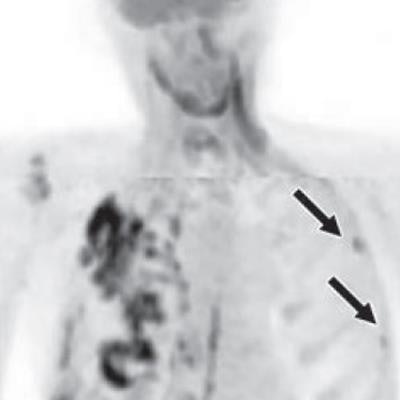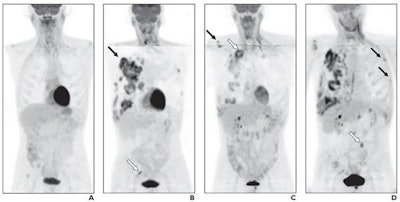
Using PET/CT for follow-up at a later interval than what's recommended by existing guidelines can potentially adjust the management of patients who have been treated for oropharyngeal squamous cell carcinoma (OPSCC), according to a study published online March 5 in the American Journal of Roentgenology.
Researchers from the University of Texas (UT) Southwestern Medical Center found that PET/CT scans of OPSCC patients during the final 18 months of a two-year follow-up period after treatment were effective in determining which patients had disease recurrence or metastases and needed their management adjusted for additional therapy.
"We found that PET/CT in the last 18 months of the two-year follow-up period was positively associated with change in patient management," wrote lead author Helena You and colleagues from UT's departments of radiology and oncology. "This finding is consistent with previous studies that have shown posttreatment PET/CT to impact patient management."
Indeed, FDG-PET/CT is well known for its ability to accurately stage all types of cancer, assess a patient's response to treatment, and detect disease recurrence and metastases. PET/CT findings also can be used to monitor the efficacy of treatment and change patient management if necessary. However, there remains some debate about the optimum time to scan patients with OPSCC after treatment to determine their posttreatment condition.
"Although studies have found PET/CT to be useful for assessment of head and neck cancers, little is known about the timing of posttreatment PET/CT, and the [National Comprehensive Cancer Network] NCCN guidelines do not specify a recommended timing sequence beyond the first six months after treatment completion," the authors wrote.
They therefore decided to look at the effectiveness of PET/CT follow-up beyond the NCCN guidelines, for up to two years after the completion of therapy. In particular, the team focused on scans in the last 18 months of the two-year window, comparing the impact on patient management for patients who got PET/CT to those who didn't.
The following PET images are from a 66-year-old man with stage IVA squamous cell carcinoma at the tongue base. He was treated with surgery and adjuvant chemoradiation. Images were constructed from two separate FDG-PET/CT scans from the midbrain to clavicle and clavicle to midthigh. Chemotherapy was stopped in favor of palliative care.
 One PET/CT (A) was acquired five months after therapy and shows no signs of recurrence. The second scan (B) was performed 18 months after therapy and shows metastatic disease in the right hemithorax (black arrow) and right posterolateral pelvis (white arrow). The third scan (C) was conducted two months after the second PET/CT and shows a partial response of previous lesions to treatment and new bone (black arrow) and lung (white arrow) metastases. A fourth and final PET/CT (D) was obtained three months after the third scan and shows the disease progressing with new metastases in ribs (black arrows) and sacroiliac joint (white arrow). Images courtesy of AJR.
One PET/CT (A) was acquired five months after therapy and shows no signs of recurrence. The second scan (B) was performed 18 months after therapy and shows metastatic disease in the right hemithorax (black arrow) and right posterolateral pelvis (white arrow). The third scan (C) was conducted two months after the second PET/CT and shows a partial response of previous lesions to treatment and new bone (black arrow) and lung (white arrow) metastases. A fourth and final PET/CT (D) was obtained three months after the third scan and shows the disease progressing with new metastases in ribs (black arrows) and sacroiliac joint (white arrow). Images courtesy of AJR.The study included 149 patients (mean age: 55 ± 9 years) who were diagnosed with oropharyngeal squamous cell carcinoma between 2006 and 2015 and who met the inclusion criteria: stage III, IVA, or IVB OPSCC, completion of chemoradiation therapy, and at least two years of follow-up after treatment.
| Impact on patient management of PET/CT in last 18 months of follow-up | ||
| Patients with PET/CT | Patients with no PET/CT | |
| Positive for cancer | 9.9% | 8.5% |
| Change in patient management | 72.7% | 33.3% |
| No change in patient management | 27.3% | 66.7% |
The researchers also noted benefits for patients beyond the detection of cancer recurrence and changing their care management to potentially more effective treatments.
"Elucidating the clinical value of follow-up PET/CT in this posttreatment period would help determine optimal timing for performing PET/CT while avoiding unnecessary cost and radiation exposure to patients," they added.




















